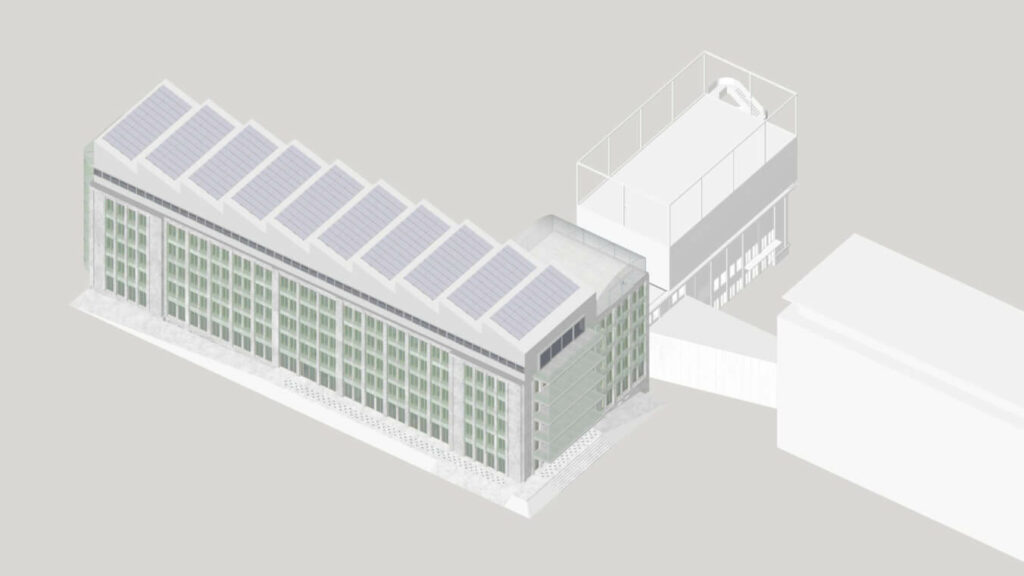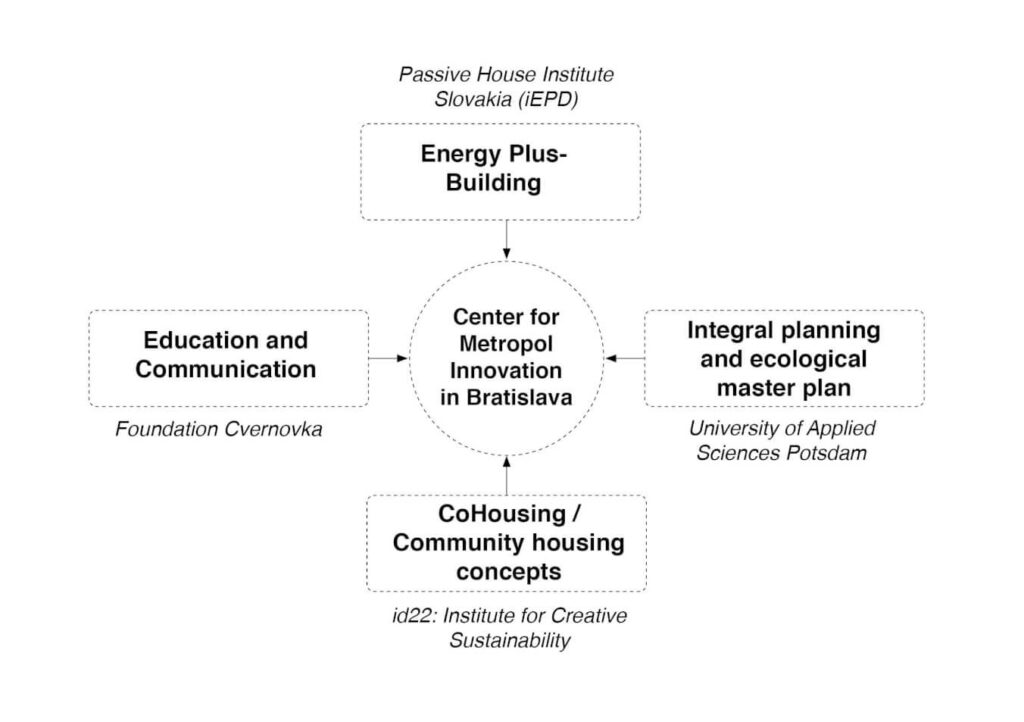Building Social Ecology is a documentation of social-ecological building projects and typical design elements that occur in these projects. We have identified typical design patterns that can be found frequently and in different forms in the projects. The method is based on the “Pattern Language” by Christopher Alexander, Sara Ishikawa and Murray Silverstein. This method was developed with the intention of providing a tool for planning and designing living cities, buildings and structures (Alexander et al. 1977). In generalised form, these patterns are combinable, interrelated and synergistic design elements that can serve as a source of inspiration for architects, project developers and residents to develop their own social-ecological projects.
This documentation was produced as part of the DBU-funded research project “Centrum for Metropolitan Innovation Bratislava”, for which, among other aspects, already realised social and ecological examples were analysed (“good practice”).
The research project “Centre for Metropolitan Innovation in Bratislava” (CMI.BA) in “Nová Cvernovka”
The international and interdisciplinary research project “Centre for Metropolitan Innovation in Bratislava” (CMI.BA) aimed at developing a socio-ecological overall concept for the reconstruction of the socio-cultural centre “Nová Cvernovka” in Bratislava. Nová Cvernovka is a socio-cultural centre in the north of the Slovakian capital Bratislava. It is located in the building complex of a former chemistry college from the 1950s. The “Nadácia Cvernovka” Foundation leased the buildings and the surrounding grounds from the regional government in 2016 for an initial period of 25 years. Since its inception, the “Nová Cvernovka” project has developed into an important creative landmark of the cultural scene in Bratislava.
As part of the research project, a concept for the socio-ecological transformation of the former dormitory was developed that combines high ecological goals with long-term favourable rents, low operating costs and favourable life cycle costs. CMI.BA is to become a model project of ecologically and socially sustainable building modernisation that combines innovative approaches of participatory planning, social use and ecological building renovation to realise the first plus-energy building in Slovakia. Due to the representative building typology, this project has a great transfer potential for similar projects in Slovakia and other European countries.

Research fields of interest and project partners
The CMI.BA research project comprises four central fields of intervention, which are implemented by the following project partners.

Potsdam University of Applied Sciences: Integral planning and ecological building methods
The “Institute for Applied Research Urban Future” (IaF) is an interdisciplinary research institution of the “Potsdam University of Applied Sciences” (FHP) and was founded in 2014. Under the research focus “Design – Build – Maintain”, various questions concerning the physical, spatial and social dimensions of sustainable development of the built environment are investigated. Within the CMI.BA project, the FH Potsdam team leads and coordinates the work of all project partners and develops an overall ecological concept. An important building block for this is integral planning, through which all important stakeholders are involved in the planning process at an early stage. The FHP is also mainly responsible for collecting “best practice” examples and creating the socio-ecological design patterns.
Institute for Creative Sustainability (id22): Co-Housing and Social Innovation
id22 is an interdisciplinary, non-profit organisation in Berlin that researches and supports collaborative forms of housing in the context of sustainable, cooperative urban development. Inclusion and self-organisation are at the forefront. For many years, id22 has been doing research, education and networking work and has published numerous papers on participatory and communal housing cultures (CoHousing Cultures).
The development of housing concepts and the monitoring of the participation process are the central fields of action of the “Institute for Creative Sustainability” in the CMI.BA project.
Passive House Institute Slovakia (iEPD): Plus-Energy-Buildings
The Passive House Institute (iEPD) is a non-political, voluntary, non-governmental organisation. As an association, iEPD promotes the development of sustainable architecture and open spaces in Slovakia and, in particular, the provision of information and knowledge on the construction of passive houses. iEPD has been involved in the implementation of many national and international research projects. In the CMI.BA project, iEPD is investigating the energy status of the building and developing an energy concept for converting it into a plus-energy building.
Nadácia Cvernovka: Education and Communication
The Nadácia Cvernovka Foundation was established with the aim of renovating the former industrial area of Cvernovka in Bratislava and filling it with life by offering social, cultural and financial support to artists and the public. In this way, the foundation wants to contribute to the improvement of living conditions and perspectives in the city and in society. The revitalisation of the Cvernovka area is gradually creating a cultural and meeting centre in Bratislava. The fields of action of the “Nadácia Cvernovka” Foundation in the CMI.BA project include communication with stakeholders and public administrations, public relations work and the preparation of planning documentation for the plus-energy building.
Alexander, Christopher / Ishikawa, Sara / Silverstein, Murray (1977): A Pattern Language: Towns, Buildings, Construction. Oxford University Press, New York. https://www.einemustersprache.de/
Downloads
| Project Report (English) | Download PDF |
| Project Report (German) | Download PDF |
| Project Report (Slovak) | Download PDF |
Learnings from housing projects
c13 Circle House (Lisbjerg) CRCLR House Generationenwohnen Giesserei Gleis 21 Heizenholz Hunziker Areal IBeB Kalkbreite Künstlerateliers Erlenmatt Ost La Borda Möckernkiez Quartier WIR Rommelmühle Sargfabrik Solares Direktgewinnhaus N11 Spreefeld StadtErle The Collective Old Oak UfaFabrik wagnisART Werkpalast Lichtenberg Wohnprojekt Südstadtschule View all24 projects